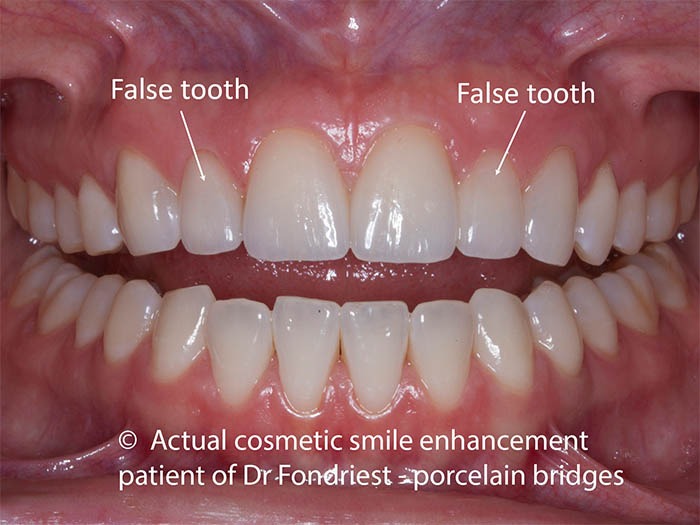
What an awful feeling it is to lose a tooth as an adult. It’s embarrassing, possibly painful, and can be a nuisance as well. Trying to speak and chew after losing a tooth can feel uncomfortable and unnatural. It can also be overwhelming, when you consider how many restorative options there are for completing your smile. Dental implants are a popular choice, as are dentures. But did you know that dental bridges are another great option, one that might be right for you? There are many benefits of dental bridges. They offer stability and beauty, making them a great way to regain your confidence after tooth loss.
What Is a Dental Bridge?
Like many restorative dental treatments, bridgework uses a replacement tooth to fill the gap created by the tooth loss. What makes it unique, however, is that it is secured in place by crowns that are affixed to the teeth adjacent to the gap. This creates not only a strong restoration, but a beautiful one as well, since the porcelain crowns and replacement tooth will all be carefully crafted to match your natural teeth. Porcelain crowns cover the entire exposed portion of each abutment tooth with durable porcelain that is not only shaped to look like a natural tooth, but also dyed to match the specific color of your smile. In between these crowns, an artificial tooth hovers over the socket of the missing tooth. This section of the bridge replaces tooth function and restores your ability to chew with ease.
Another benefit of a dental bridge is that it helps to preserve your tooth alignment after tooth loss. Without some form of restoration, you may encounter severe, even painful misalignment.
Much like a highway bridge, dental bridgework consists of two anchor points which support a structure over a gap. Traditional bridges include two porcelain crowns, bonded to surrounding teeth, which support an artificial tooth in the middle. The teeth surrounding the gap, known as abutment teeth, support the bridge.
Traditional Bridge Procedure
A bridge provides a natural looking, dependable replacement tooth (or teeth). The replacement tooth is connected by securing crowns to adjacent teeth.
After your consultation, here’s what you can expect from your dental bridge procedure:
- Dr. Fondriest will prepare two teeth for crowns.
- We will take an impression of your prepared teeth and send it to our ceramist.
- Dr. Fondriest will attach a temporary bridge that protects the prepped teeth until your next appointment.
- When your permanent bridge is ready, you’ll come in for an appointment. Dr. Fondriest will adjust the prosthetic as necessary to give you a comfortable fit and properly aligned bite.
- Once all adjustments are made, the bridge will be cemented in place.

Two anterior dental bridges made with ovate pontic designs on the false teeth.
Benefits of Dental Bridges
Bridgework is a viable solution to replace missing teeth, and it costs less than other treatments. Other benefits include:
- Natural looking and durable
- They are permanently attached
- Prevent the shape of your face from changing from tooth loss
- Can replace one or more teeth
- The false tooth can be made to look real with the ovate pontic design
- Corrects bite abnormalities and distributes the forces evenly
- Can be accomplished in two easy appointments
- Bridges can be a less expensive alternative to dental implants.
What Makes Bridges Different?
- Increased confidence is one of the most important benefits of dental bridges
- Increased arch stability, both while smiling and chewing.
- Bridges are a more affordable option than dental implants
- The teeth on either side of the gap are crowned
- Because a porcelain bridge uses porcelain crowns, your completed restoration will be beautiful and natural-looking.
Don’t Settle for an Incomplete Smile
There are several important reasons to complete the smile after tooth loss, not the least of which is to improve the look of your smile. Other important reasons include:
- When a tooth is lost, nearby teeth often shift trying to fill the created gap. Another one of the benefits of dental bridges is that they close gaps in smiles. Therefore, prosthetic dentistry can help to preserve remaining teeth’s alignment, helping to prevent further loss of teeth as well as discomfort, associated with misaligned teeth.
- Dental bridges also help to improve your smile. Missing teeth can make it difficult to chew comfortably, which can eventually lead to poor nutrition, especially if several teeth are missing. A prostheses helps makes meals more enjoyable, and getting proper nutrition more sustainable.
- In some cases, prosthetics can even help to supply nutrients to the jaw, which help to maintain its structure over time. Dental implants are the best way to do this, because implant posts help to mimic the role of a healthy tooth root. They supply nutrients to the jaw each time you chew. Implants can even be used in conjunction with a bridge to complete a smile.
Learn more about the benefits of all the types of dental bridges
Dental bridges are an effective form of smile completion because they rely on dental crowns to help stabilize a replacement teeth, such as a partial denture. These crowns are either affixed to remaining teeth, or sometimes stabilized using dental implants. Either way, they are permanently attached to the replacement tooth or teeth, in order to complete the smile cosmetically as well as functionally. Bridges are excellent alternatives to implants. Many patients choose not to go through the long process for implants.
You can expect a traditional bridge to last about 15 years. Other types of bridges do not last as long and are not reimbursed by dental insurance as well.
If you would like to learn more about the benefits and disadvantages of bridges, call for a second opinion. To schedule a consultation, call our office today at 847-234-0517.
